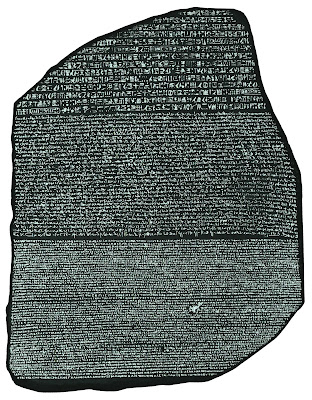I took hardly any photos today. This one was outside the pub where we had lunch near the Museum of London. We started the day at the British Museum, and it was an incredible tour. We had a personal tour, with only one other person, by a museum docent who hopes one day to be the British Museum director! She was excellent, and we learned so much, even though we saw only 0.0002% of the museum's artifacts. Best tour ever!
Our British Museum tour began at 10 am, and we walked to it. We were delighted to see that there would be just one other person on our tour, so could hear everything the guide said. She was excellent. She focused on explaining just a "few" of the artifacts in detail vs trying to show us as many items as possible.
The museum was founded in 1753 when Sir Hans Sloane, a physician and scientist, bequeathed his vast collections to the state. In 1823, King George IV gave to the museum the King's Library, assembled by George III. Parliament gave the museum the right to a copy of every book published in the country, thereby ensuring that the museum's library would expand indefinitely.
There are now about 13 million items in the British Museum! Our guide spoke extensively about the disputed items that Britain "stole" from other countries, several of which are openly contested to this day. Chief among these is probably the most famous piece in the museum, the Rosetta Stone, which Egypt still is wanting back. She said they gave Egypt a very expensive replica of it!
Here are some of the items we learned about:
Warren Cup, which is a Greek cup from 15 BC and acquired in 1928. It is engraved with homosexual activity between two men, and was therefore hidden from the public until the 1980s.
Aigina Treasure Pendant, a piece of Greek jewelry from about 3000 BC.
Lewis Chessmen, walrus ivory chess pieces found on the Scottish Isle of Lewis in 1831. They were made in Norway in about 1150. Each piece is intricately carved and represents medieval aristocracy of kings, queens, knights, bishops, rooks, and faceless pawns. Janet and I bought a souvenir of one the queen pieces.
Mummies - We learned a lot about how they were done and all the artifacts put inside the caskets to be used in the person's afterlife. Assyrian stone relief - our guide explained the action depicted in a lion hunt relief across several walls, dating from 625 BC. Lion hunting was the sport of kings, and one Assyrian king claimed to have killed 450 lions.
Too much to remember! But we were captivated by the history and culture derived from the treasures we saw that morning. We bought several items, including heavy books, so we walked back to our flat to drop them off before taking the subway to the next museum.
You can see on the wall to the left in the photo above that it was the site of one of the original city gates - the Aldersgate, demolished in 1761. We stopped into this pub, Lord Raglan, for lunch. It was just south of the Museum of London, and just north of St. Paul's Cathedral. It was pretty quiet inside, on our Sunday afternoon.
The Museum of London covers the city from prehistoric to modern times. It is overlooking the remains of the Roman city wall and on the edge of the oldest part of London. It is primarily concerned with the social history of London and its inhabitants. We participated in a short tour, but much of what she discussed we had already learned on our previous tours.
There was more in-depth information on what it was like to live during the various eras from the middle ages to the current time. The exhibit on the Great Fire was interesting, and the Victorian slums.
They had some hands-on sections on the Great Fire, and here's Janet modeling what her 2nd graders would have done on a field trip.
Janet's foot got sore, so she sat down with Paddington Bear while I finished touring "recent" London, the 20th century stuff. I enjoyed it all, particularly the items and events I personally remember during my lifetime.
My final Sunday picture was where we ate dinner, at this pub very near to our flat. We both ordered their Sunday roast specials - tons of food at a special price, with their roasts as the main entree.
That night we went to the massive Odeon Cinema in Leicester Square to watch Victoria and Abdul, which we liked (other than the 30 minutes of ads and previews! And the $18 ticket price per person!).
Finally, we packed our bags to be all ready to depart the next morning. What an incredible few days we had in this exciting and historic town.









No comments:
Post a Comment